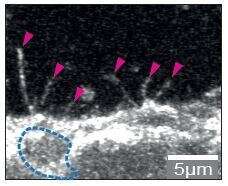Cells are collective thinkers

Cells, like humans, cast votes to make decisions as a group. But how do they know what to vote for? Researchers at the Francis Crick Institute and King's College London have uncovered how cells actively seek information in order to make faster and better collective decisions to coordinate the growth of new blood vessels. This provides a new basis for understanding intelligence in cells.
The process of how cells precisely and quickly coordinate action when they create new tissue is complex. They must collectively decide which cells should take on specific jobs and ensure that not too many or too few cells are fulfilling each role.
In their study, published in Philosophical Transactions of the Royal Society B, the researchers found that when growing new blood vessels, cells make collective decisions using a process of active perception. This is where moving around to better sense the environment helps inform a decision.
The researchers compare this to entering a dark, unfamiliar room and extending your arms to feel around the wall for a light switch. In the case of the cells, they reach out long 'fingers' and feel their way in the environment. This allows them to quickly choose the cell that senses the most signal from the surroundings to become their leader. This leader, called a tip cell, drives the new blood vessel forward.
Katie Bentley, senior author and group leader of the Cellular Adaptive Behaviour Laboratory at the Crick and senior lecturer at King's College London says: "In most biology textbooks, processes are set out step by step in a certain order. Molecule A binds to receptor B and causes movement C. In the case of this important collective cell decision, steps happen alongside each other rather than consecutively, as cells simultaneously move about while 'deciding' how to form new tissue.
"This ability to use feedback from moving through the world while making a choice is something we usually associate with 'higher-organisms' so recognising how these processes also play a role in more basic living systems could reveal fundamental aspects of biological function driving them to behave as they do.
"And in cases where this process has gone wrong, it could even unlock new therapies and treatments that impact these feedback processes."
In their proof of concept work, the researchers focussed on blood vessel formation, which is vital to healthy tissue development and repair, and is often dysregulated in disease.
At the start of this process, some endothelial cells along the outside of an existing blood vessel turn into tip cells. These tip cells have long finger-like protrusions on their surface, called filopodia, and are the first to move out from the existing vessel to form the head of the new, sprouting vessel.
Many aspects of the timing and cell interactions involved in this process, including how the endothelial cells decide which of them should become tip cells, are not yet understood.
Using computer simulations and studies of zebrafish embryos, the researchers found that the filopodia start forming on the cell surface before it has committed to becoming a tip cell. The filopodia then extend out into the surrounding tissue and detect signals which can either trigger the cell to become a tip cell or inhibit it. This process of filopodia movement and sensing constitutes an active perception feedback loop.
Importantly, to stop all the cells becoming tip cells, neighbouring cells send signals to each other so that only every other cell specialises.
Bahti Zakirov, author and researcher at the Crick and King's College London says: "It was exciting to find that the creation of filopodia was taking place before the cells had fully become tip cells. Until now these protrusions have been considered as merely the end product of the cell decision making process. We've flipped this on its head and shown that the cells use filopodia to better sense their environment and inform their decision—highlighting the feedback between movement and sensing as an important player in the decision-making process."
When the researchers disrupted the filopodia in their computer models and in zebrafish embryos, fewer tip cells were selected and this selection happened more slowly. This delayed process has previously been shown to lead to the formation of less dense blood vessel networks.
Zakirov continues: "If tip cell selection goes wrong or is slowed down this can lead to poorly branched or abnormal vessel networks, limiting blood flow. This in turn, can contribute to diseases such as cancer, retinopathy and HHT- hereditary haemorrhagic telangiectasia. A greater understanding of how to speed up or alter the branching tempo could therefore lead to new therapies which can regulate blood vessel density. This could also help in the creation of artificial organs or tissues as these also need dense blood vessel networks."
Bentley adds: "This work has not only given us a a fresh perspective on the tip cell selection process, revealing a hidden, yet vital time-keeping role for filopodia, but also opened the door to a myriad of new and exciting research directions. We will be exploring some of these important questions in future work, with a view to better interpreting and understanding cell behaviour."
More information: Bahti Zakirov et al. Active perception during angiogenesis: filopodia speed up Notch selection of tip cells in silico and in vivo, Philosophical Transactions of the Royal Society B: Biological Sciences (2021). DOI: 10.1098/rstb.2019.0753
Journal information: Philosophical Transactions of the Royal Society B
Provided by The Francis Crick Institute



















